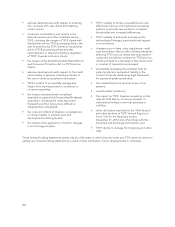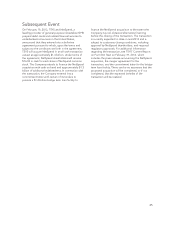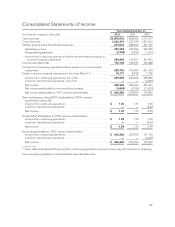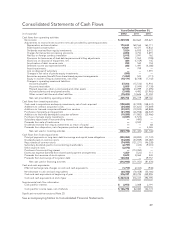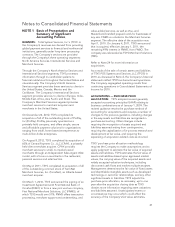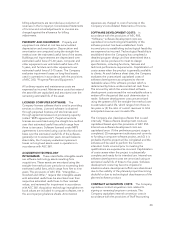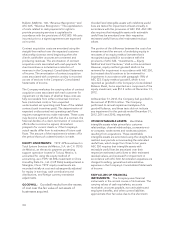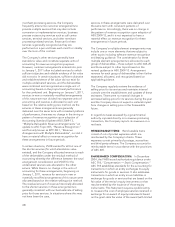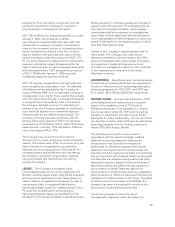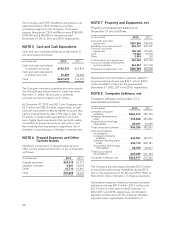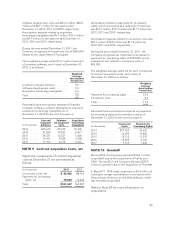NetSpend 2012 Annual Report Download - page 36
Download and view the complete annual report
Please find page 36 of the 2012 NetSpend annual report below. You can navigate through the pages in the report by either clicking on the pages listed below, or by using the keyword search tool below to find specific information within the annual report.billing adjustments are recorded as a reduction of
revenues in the Company’s Consolidated Statements
of Income and actual adjustments to invoices are
charged against the allowance for billing
adjustments.
PROPERTY AND EQUIPMENT: Property and
equipment are stated at cost less accumulated
depreciation and amortization. Depreciation and
amortization are computed using the straight-line
method over the estimated useful lives of the assets.
Buildings and improvements are depreciated over
estimated useful lives of 5-40 years, computer and
other equipment over estimated useful lives of 2-
5 years, and furniture and other equipment over
estimated useful lives of 3-15 years. The Company
evaluates impairment losses on long-lived assets
used in operations in accordance with the provisions
of ASC 360, “Property Plant and Equipment.”
All ordinary repairs and maintenance costs are
expensed as incurred. Maintenance costs that extend
the asset life are capitalized and amortized over the
remaining estimated life of the asset.
LICENSED COMPUTER SOFTWARE: The
Company licenses software that is used in providing
services to clients. Licensed software is obtained
through perpetual licenses and site licenses and
through agreements based on processing capacity
(called “MIPS agreements”). Perpetual and site
licenses are amortized using the straight-line method
over their estimated useful lives which range from
three to ten years. Software licensed under MIPS
agreements is amortized using a units-of-production
basis over the estimated useful life of the software,
generally not to exceed ten years. At each balance
sheet date, the Company evaluates impairment
losses on long-lived assets used in operations in
accordance with ASC 360.
ACQUISITION TECHNOLOGY
INTANGIBLES: These identifiable intangible assets
are software technology assets resulting from
acquisitions. These assets are amortized using the
straight-line method over periods not exceeding their
estimated useful lives, which range from five to nine
years. The provisions of ASC 350, “Intangibles —
Goodwill and Other,” require that intangible assets
with estimated useful lives be amortized over their
respective estimated useful lives to their residual
values, and reviewed for impairment in accordance
with ASC 360. Acquisition technology intangibles net
book values are included in computer software, net in
the accompanying balance sheets. Amortization
expenses are charged to cost of services in the
Company’s Consolidated Statements of Income.
SOFTWARE DEVELOPMENT COSTS: In
accordance with the provisions of ASC 985,
“Software,” software development costs are
capitalized once technological feasibility of the
software product has been established. Costs
incurred prior to establishing technological feasibility
are expensed as incurred. Technological feasibility is
established when the Company has completed a
detailed program design and has determined that a
product can be produced to meet its design
specifications, including functions, features and
technical performance requirements. Capitalization of
costs ceases when the product is generally available
to clients. At each balance sheet date, the Company
evaluates the unamortized capitalized costs of
software development as compared to the net
realizable value of the software product which is
determined by future undiscounted net cash flows.
The amount by which the unamortized software
development costs exceed the net realizable value is
written off in the period that such determination is
made. Software development costs are amortized
using the greater of (1) the straight-line method over
its estimated useful life, which ranges from three to
ten years or (2) the ratio of current revenues to total
anticipated revenue over its useful life.
The Company also develops software that is used
internally. These software development costs are
capitalized based upon the provisions of ASC 350.
Internal-use software development costs are
capitalized once: (1) the preliminary project stage is
completed, (2) management authorizes and commits
to funding a computer software project, and (3) it is
probable that the project will be completed and the
software will be used to perform the function
intended. Costs incurred prior to meeting the
qualifications are expensed as incurred. Capitalization
of costs ceases when the project is substantially
complete and ready for its intended use. Internal-use
software development costs are amortized using an
estimated useful life of three to five years. Software
development costs may become impaired in
situations where development efforts are abandoned
due to the viability of the planned project becoming
doubtful or due to technological obsolescence of the
planned software product.
CONTRACT ACQUISITION COSTS: The Company
capitalizes contract acquisition costs related to
signing or renewing long-term contracts. The
Company capitalizes internal conversion costs in
accordance with the provisions of Staff Accounting
33



